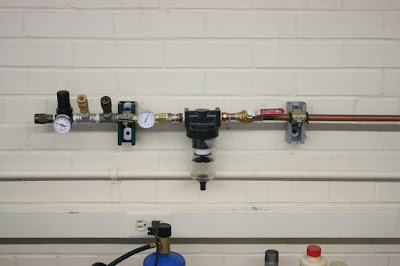
I stated in a previous post that the air compressor and tank are outside the building. They are in a 100+ degree shed all summer (which is from Feb 16- Feb 12, as far as I can reckon) without any kind of chiller or cooler before it comes through the wall. This drastic change in temperature between the outdoor temps and the air conditioned lab generated gallons of water condensing in the airline. This corroded the pipes and fittings, plugged the tools, and clogged the air abrasive unit. Also, and apologies to the elderly, but I think you'll know what I mean, when you unplugged a tool from the quick connect you got blasted in the face with oily wet air that smelled like old man for hours.
The first picture shows the air coming in as a Z of black pipe to the left of and behind the first filter. That filter is the primary water trap, which when drained yields a few ounces of water every day. The next unit is a general particulate prefilter, before the oil filter, with the red label, and finally, the long tube of the dessicant filter, that holds four pounds of cobalt indicating silica beads. This multi-pronged attack seems to have made a substantial difference so far in the amount of moisture that harasses us.
After the filters, the plumbing gets slightly more complicated. The 1/2" copper schedule L line exits to a T fitting, and one pipe runs up and across the ceiling to supply air to the middle of the room, where large worktables will soon sit. The other line runs down, and then splits to two regulators, where all of our air then runs in parallel lines of low and high pressure. The high pressure is for Microjacks, AROs, etc, and the low is for foot pedals, air guns, and some of the new tools that we are now getting from Charlie Magovern. We then have air hookups spaced every four to five feet equivalent with the location of workstations, with two quick conn
 ects for each line. Both ceiling and wall lines also have ball valve shut-offs inline after the filters for safety and maintenance.
ects for each line. Both ceiling and wall lines also have ball valve shut-offs inline after the filters for safety and maintenance.Some of our offices have air supplied from the same system also, here you can see the set up at the workstation in my office. The air comes in from the right of the photo, passes through a ball-valve, then an oil an moisture trap. I've installed a small ball-valve operated pressure "indicator", it's not a real regulator, just so that I know what the incoming pressure is. After that I have two high pressure quick connects, an actual regulator, and a low pressure outlet for my foot pedal. The air line running to my offices passes through about 30 feet of non climate controlled collections, then back into the AC, so I still get a fair amount of moisture condensing there and ending up in the filter. After filter is now much much drier than it was before this changeover.












